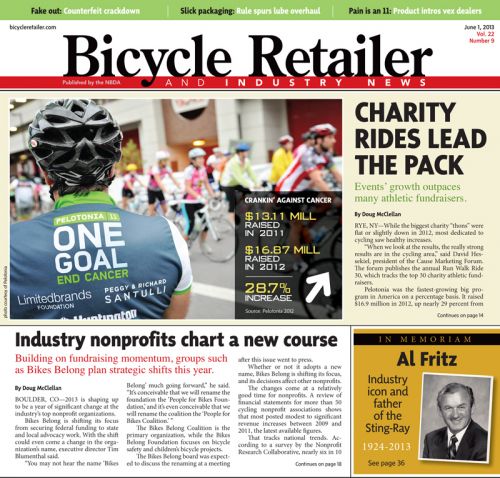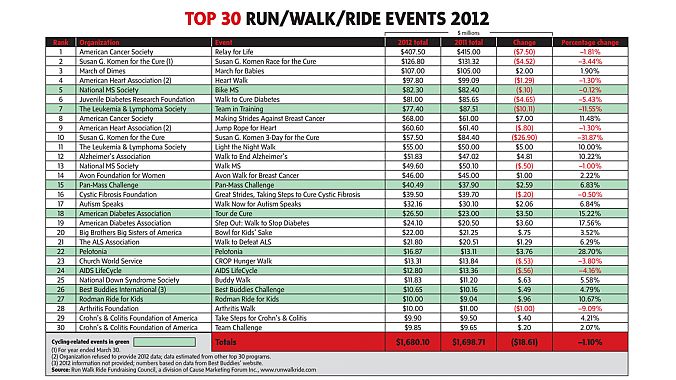RYE, NY (BRAIN) — While the biggest charity “thons” were flat or slightly down in 2012, most dedicated to cycling saw healthy increases.
“When we look at the results, the really strong results are in the cycling area,” said David Hessekiel, president of the Cause Marketing Forum. The forum publishes the annual Run Walk Ride 30, which tracks the top 30 charity athletic fundraisers.
Pelotonia was the fastest-growing big program in America on a percentage basis. It raised $16.9 million in 2012, up nearly 29 percent from the prior year, a rate Hessekiel said is “just spectacular.”
Offering rides of 25 miles to two days, Pelotonia benefits “The James” in Columbus, Ohio, officially known as the Ohio State University Comprehensive Cancer Center—Arthur G. James Cancer Hospital and Solove Research Institute.
Organizers are targeting $20 million in revenue this year, said Krista Dorsten, director of marketing and communications. She said rider registrations are up from the same time last year.
“We’ve found that a lot of our riders try out the 25-mile ride their first year, in an effort to get two wheels under them, in regards to both riding and fundraising, and then commit to the longer rides once they realize what they’re capable of,” Dorsten said.
Pelotonia was founded by Tom Lennox, an executive at Abercrombie & Fitch. Lennox, a cancer survivor, rode the 2008 Pan-Mass Challenge across Cape Cod, Massachusetts, with Mike Caligiuri, director of The James. The two bonded, and Lennox left A&F later that year to create Pelotonia, where he is CEO.
Pelotonia started only in 2009, but the ride that it is modeled after has also continued to boom. The Pan-Mass Challenge raised more than $40 million in 2012, up nearly 7 percent from the prior year.
Its growth is even more impressive because the challenge has been running since 1980, making it the nation’s oldest fundraising bike-a-thon. Every rider-raised dollar goes to the Dana-Farber Cancer Institute in Boston through its Jimmy Fund.
“In spite of the economic downturn, there are still a considerable number of people who are really getting into cycling, who want to get good bikes and want to get out there and ride fast, and are looking for interesting opportunities to do that,” Hessekiel said.
The 2012 Top 30 list shows a slight drop from the prior year, to $1.68 billion from $1.7 billion. Hessekiel said the results were skewed by the PR disaster at Susan G. Komen for the Cure.
The Komen foundation decided in January 2012 to eliminate $680,000 in grants to Planned Parenthood. After a media firestorm, the organization reversed its decision. But the heavy criticism led to a sharp drop in fundraising, especially for the Komen “3-Day for the Cure” walk.
Because Komen’s fiscal year ends in March, Hessekiel said he expects its 2013 numbers to be down significantly as well.
“Whether you’re running a company or a cause, there are huge prices to pay for getting caught up in a controversy over a very divisive issue,” he said. “In this case, they handled it in such a way that they lost support on both sides of the issue.”
If the Komen results were excluded from the Top 30, overall results would be slightly up for 2012, Hessekiel said.
Most charity rides take place in the summer, but one organization—the Memorial Sloan-Kettering Cancer Center—has already had a banner 2013 for its indoor spinning event.
Known as Cycle for Survival, the event this year brought in $14 million, up significantly from $8.3 million in 2012. “It seems to be a shoo-in for next year’s Run Walk Ride 30,” Hessekiel said.
Sloan-Kettering runs Cycle for Survival in cooperation with the Equinox chain of health clubs, allowing it to expand across the country, said Katie Kotkins, the event’s director. This year’s event featured 12,000 riders in 10 cities.
“We’re an indoor cycling event, so we’re in a different time of year” from most cycle fundraisers, she said. “We’re team based, so people really rally with their groups of friends, families and co-workers, in part to raise money.”
Cycle for Survival was founded in 2007 by Jennifer Goodman Linn, who had been treated for cancer at Memorial Sloan-Kettering, and her husband, Dave. Monies raised go to treat rare forms of cancer that are often underfunded.
“She loved cycling and she always said that MSK took care of her physically and Equinox took care of her mentally,” Kotkins said. “She wanted to combine these two things to give back to MSK. Her original goal was to raise $10,000, and we raised $250,000.”
Linn, who suffered from sarcoma, died in 2011 at age 40.
“She realized that indoor cycling was something that anybody could do,” Kotkins said. “We have people who ride all eight hours, which is amazing, but then we also have people who sit on the bike for 10 minutes or who are in their 80s and 90s and just want to be there to show their support and give back.”
Meanwhile, another big cycling fundraiser is set to launch this year.
The Fred Hutchinson Cancer Research Center in Seattle, often known as “Fred Hutch,” is sponsoring the vividly named Obliteride in August. The ride will complement the institution’s traditional Holiday Gala, which has been a mainstay of its fundraising for nearly 40 years.
Amy Lavin, executive director of Obliteride, said the group chose cycling in part because Seattle has a big community of cyclists.
“We believe cycling is incredibly accessible to most people, and therefore everyone can participate,” Lavin said.
People who don’t want to ride can be one of the 1,000 volunteers that Obliteride is seeking to help run the event.
“While a lot of people can bike, some people might choose not to. Some people can choose to volunteer. Some people might choose to do fundraising but not get on the bicycle,” Lavin said.
She cited Pelotonia, Cycle for Survival and the Pan-Mass Challenge as inspirations for Obliteride.
“Obliteride is giving Fred Hutch an opportunity to really connect with the community. That over time ends up engaging a broader base of supporters,” Lavin said.
A high-visibility event like the ride goes beyond fundraising, she added. “It helps people really understand why it’s important to have a world-class, leading cancer research center right here in Seattle.”
As with Pelotonia, Cycle for Survival, the Pan-Mass Challenge and other charity rides, all funds raised by Obliteride riders will go to research.






